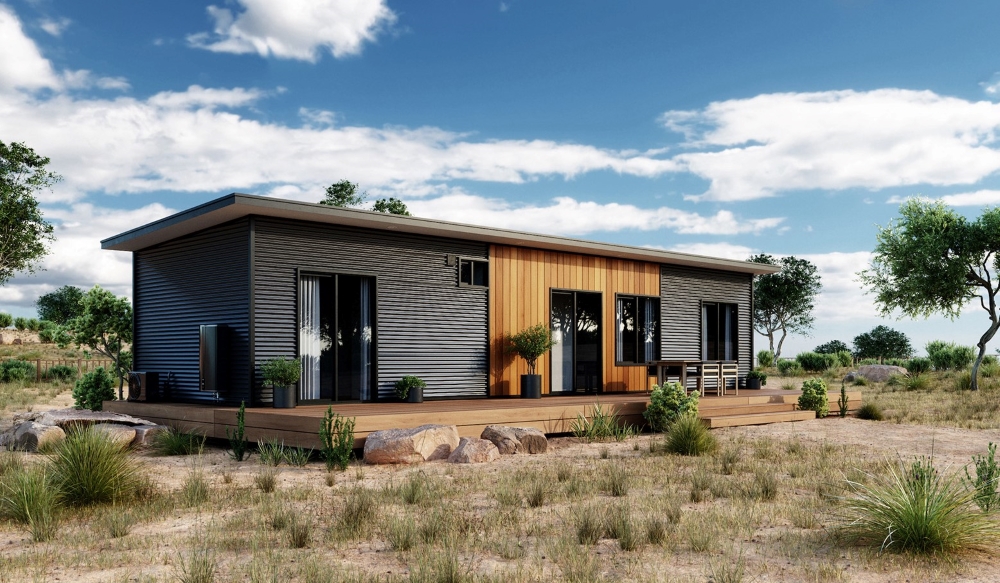The idea of moving into a newly constructed home appeals to numerous people. However, the thought of waiting during the construction phase stops many from moving forward with new construction.
Fortunately, there is an option that offers the best of both worlds and can make a newly built home an excellent choice, a transportable (also called modular) home.
What is a Transportable/Modular Home?
A transportable or modular home is a structure built away from its final location, arrives mostly assembled, and is affixed to a prepared foundation. Usually, about 90% of the construction of these homes takes place off-site.
Modular homes follow the same standards and regulations as traditional construction and are every bit as safe as houses built the conventional way.
How are Traditional Homes Built?
There are quite a few steps involved in constructing a house. While there is no set timeframe, the building process can take up to a year, depending on any setbacks. Many people believe this is the way to make their property ownership dreams come true.
- Planning and Designing – After you have purchased the property you need for your house, you will work with designers to share your vision. You may also work with a company that has preplanned homes. In this case, you must choose from their designs. However, you may have the option of making some design changes, as many companies will permit alterations.
- Getting Approvals – Before you build, you must have the necessary permits. Your contractor will send a full construction document to the local council for approval. The document outlines everything that is to take place.
- Preparing the Construction Site – What happens in this phase depends on the property’s condition. Essentially, your builder will want to survey the land, excavate if necessary, and make any underground connections.
- The Base Stage – Also called the footings, foundation, and framing phase, this is when your house begins to take shape. Once the concrete has set, the framing of your home starts, and you can see the shell of your house taking shape.
- The Exterior – Your contractor will assemble and bring together all necessary outside elements. This includes roof cover, doors, windows, gutters, brickwork, and walls.
- The Interior – The weather is not a big problem at this stage because the work is mainly done inside. Generally, this is part of construction where you see how close you are to being ready. Clients usually enjoy picking choosing colours and detail work in their new surroundings. Sometimes, the materials you choose are challenging to get, which may delay the process.
- The Fixing Stage – This is when the finishing touches are added to your house. Things like light fixtures, taps, appliances, and countertops all come together to make your house feel more like a home.
How are Transportable Homes Built?
Most of the construction work for your transportable home will occur in our factory and not on the site where you will live. This idea unsettles some people, and we respond with the analogy that their car is also built in a factory and is quality and built to exacting standards.
No timeline is set in stone, but generally, we can make your modular home move-in ready in under nine months. The biggest hindrances are council approval of your project and difficulty sourcing specific materials you requested.
- Purchasing Materials – This process can take up to three weeks, depending on the scarcity or unique nature of the materials you choose. The opposite is also true. If you decide on readily available materials or materials we keep in stock, this part of the process can be completed in around a week.
- Construction in our Factory – After getting the materials for your home, our craftsmen begin building. The process can take between four to six weeks, depending on the size of your home. When factory construction is complete, about 90% of your transportable home will be finished.
- Installation and Completion – We will deliver your transportable home to your site and take care of any necessary preparation activities. Our next steps include putting your home together and ensuring everything is secure. We will add the details you requested and make sure that your modular home is move-in ready when we hand over the keys to you. This process can take about three weeks, although it is often done faster.
The Key Differences Between Traditionally Constructed Homes and Transportable Homes
- The most significant difference between traditionally constructed homes and transportable homes is where the bulk of the construction occurs. A traditionally built home will be built from the ground up on-site. A transportable home is manufactured in a factory and assembled in your chosen location. Both types of homes must adhere to the same safety standards, and neither is inferior in that respect.
- Transportable homes take much less time to build than traditional builds. The advantage here is that transportable houses are factory-built. The process is not slowed by poor weather, which can considerably hinder traditional builds.
- The ability to customise your house can vary between the two types of construction. Some design specifics are easier to add to a modular build; depending on what you are adding, the same may be said for traditional builds.
- There is a long-standing debate regarding which kind of house is less expensive. Often, transportable homes cost a bit less than traditional builds. Prices between the builds can differ, but a large portion of the additional cost comes from adding design features and specific elements. It is difficult to compare the two types in this way because of the wide range of possibilities available.
- Some neighbourhood Home Owners’ Associations are against the construction of transportable homes. This is usually associated with the fear that this type of house will lower property values and cheapen the neighbourhood’s look. This idea is antiquated and dates back decades to the first transportable homes. Modern transportable homes are as stylish as traditionally built houses and hold their value as well.
When it comes to ease of construction, design options, and the ability to build almost anywhere, transportable homes are an ideal choice for singles, couples, or families.
To learn more about transportable homes or to schedule an appointment to discuss our homes, don’t hesitate to get in touch with Fox Transportables, and a member of our team will be glad to help you.


